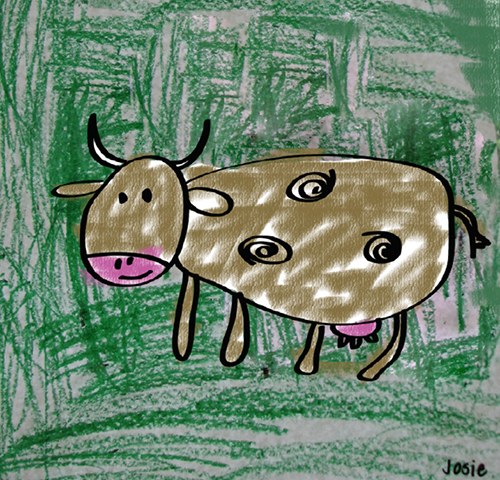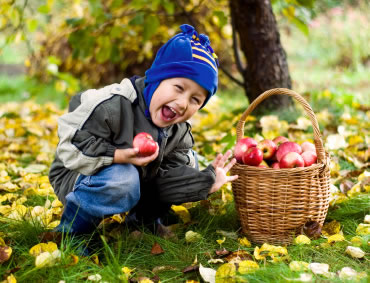As an active dramatic play activity read a favorite children’s story, then have the children pretend to be characters from that story. For example, read The Big Red Barn by Margaret Wise Brown to the children.

child's drawing of a cow
Animals from The Big Red Barn
This story is full of all kinds of farm animals. Ask the children to pick a favorite animal, then read the story again slowly, stopping on each page to allow the children to act out the part of their favorite animal on that page. Make sure each child has a turn during the story.
Here are some ideas to expand this activity
- Help the children find more information, pictures, etc. about the animals in the story.
- Children can share what they learn about their animal.
- Make clay or play dough figures of the animals.
- Play a circle game where the children pretend to be their animal when it is their turn.
- Encourage the children to make up their own story about farm animals. Write the story down.
- Have them draw pictures of their animals to illustrate the story.
- Put their book in a place where all, including parents, can enjoy what the children have accomplished!
Build and Create with Shapes
Young children need to build fine motor skills, meaning control of the small muscles in their hands. In this creative activity they will also practice recognizing shapes and will use creative skills.
What you need
- Thin cardboard or oak tag paper (or stencils of squares, triangles, circles, and rectangles of various sizes)
- Pencils
- Colored paper in a variety of colors
- Safety scissors
- White craft glue
- White construction paper
What to do
- Make stencils of the geometric shapes in a variety of sizes out of cardboard or oak tag.
- Have the children trace the shapes with the pencil on the colored paper.
- The children can cut out the shapes.
- Put all the shapes in the center of the table.
- The children can create shape pictures using the shapes and gluing them to a piece of white paper.
You may want to make this a two-part activity. Part 1 can be the tracing and cutting. Part 2 can be creating the shape pictures.
Ten Little Apples - finger play
 (Hold up fingers to match each number)
(Hold up fingers to match each number)
Ten little apples hanging on the tree, One fell off and nine we could see.
Nine little apples looking all around, One fell down and hit the ground.
Eight little apples left up there, Another fell off and flew through the air.
Seven little apples hanging on that tree, Wondering who the next will be.
Six little apples way up high, Another decided it was time to fly.
Down he went and landed on the ground, Then five little apples were all we found.
The fifth little apple decided to go, So four little apples were left in a row.
Four little apples up there in the tree, Another one fell and then there were three.
Three little apples not making a sound, One more fell to join others on the ground.
Two little apples hanging high in the air, The next one left, to see what was there.
Now one little apple hanging near a nest, Decided to fall and join the rest.
Taste and See
This activity involves tasting, colors, and math.
What you need
- Apples of various kinds and colors
What to do
- Ask the children to identify the colors of the apples.
- Cut the apples in small pieces. Have the children taste different types.
- Record their favorites.
- Make a chart to show which ones they liked the best.
Dietary Cautions
- Be aware of choking risks and food allergies when preparing and serving meals and snacks. Think about the size, shape, and consistency when choosing foods due to the potential choking risks in children. Food cut in large chunks, small hard foods, and soft and sticky foods should be avoided. The top choking hazards for children include: hotdogs, meats, sausages, fish with bones, spoonfuls of peanut butter, popcorn, chips, pretzel nuggets, raisins, whole grapes, raw carrots, fruits and vegetables with skins, and marshmallows. Be sure that food is cut in small pieces (no larger than ½ inch), grated, or finely chopped. Be sure that children are closely supervised when they are eating.
- Do not give honey to children under 12 months of age. Honey contains spores that can cause infant botulism.
- Many children have food allergies or sensitivities to food. According to the American Academy of Pediatrics, 90% of children's food allergies are from milk, eggs, peanuts, tree nuts (pecan/walnuts), fish, shellfish, strawberries, soy, wheat, and gluten. Carefully read food labels for potential risks and be sure to ask the parents if children have a known allergy or sensitivity.
- Dental health is a growing concern with young children, so it is important to keep in mind that starchy, sticky, and sugary foods can cause tooth decay. Children should brush their teeth after any meal or snack, but particularly when you serve these foods.
Activity 8-2

